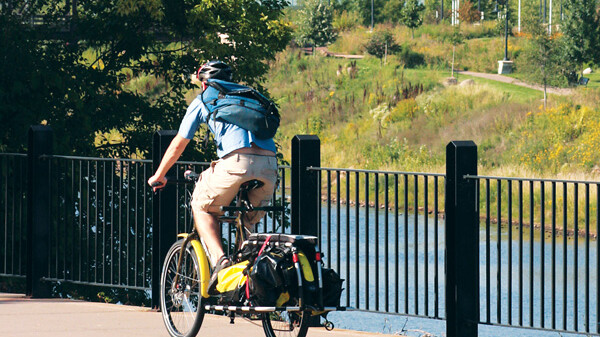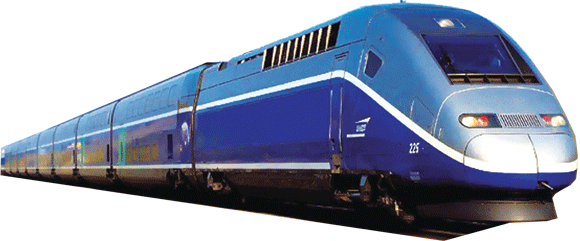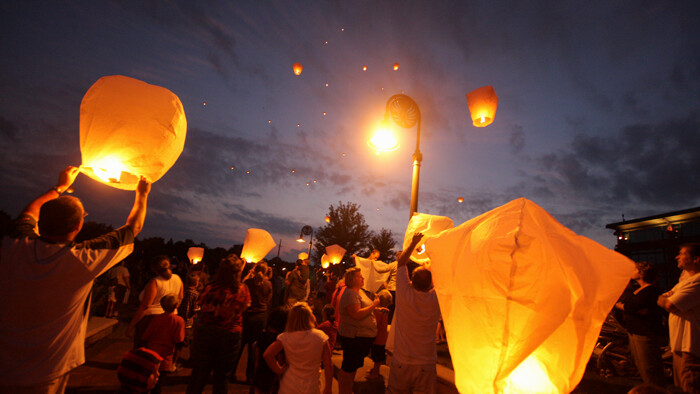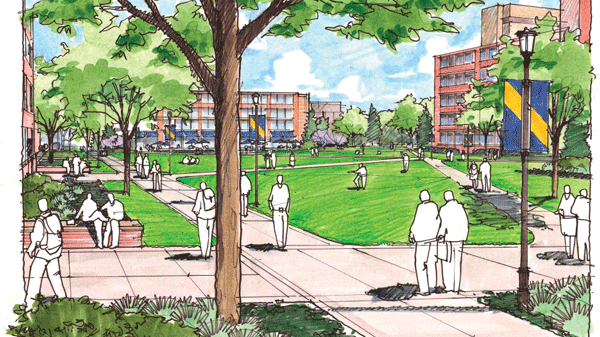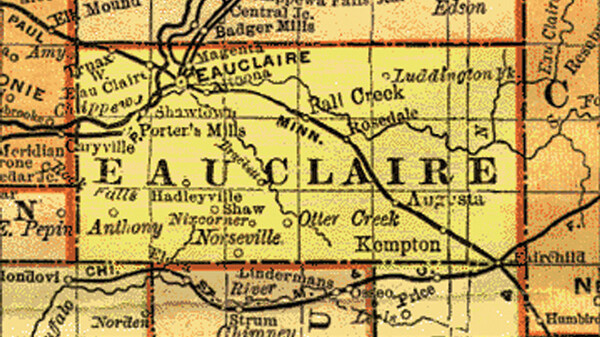According to Plans
the schematic of a bold and exciting city takes shape during Eau Claire's "planning boom"
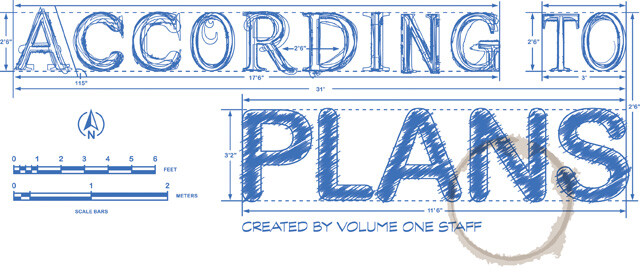
When large organizations and projects are conceived, they’re often expected to fulfill an identified need for the next 20 to 50 years. When that time is up, those involved review the new needs of the community, develop a new plan, and take the appropriate action for the next 20 to 50 years. Well right now, Eau Claire is in a particularly unique period in this cycle. A time when lots of organizations and projects (e.g. downtown, parks, waterways, event facilities, etc.) need attention. Not only for being physically insufficient, but perhaps also for being conceptually insufficient, as we’ve shifted our cultural stance on items like transportation, quality of life, and revitalization. But before any changes can actually happen, whether it be a roadway or an intangible idea, they need a plan. So as you may have deduced, we’re in the middle of the perfect storm of plans.
Several private groups, non-profits, and city/county officials are outlining the wants, hopes, and needs of the community. Many of them cover similar ground (the rivers, downtown, tourism, et al.) – some overlapping, some disagreeing – but all of them stack up to play their vital role in setting up the next half-century.
“It seems like everyone’s doing some sort of plan right now, whether it’s revisiting an existing one or starting a new one,” said former city manager Mike Huggins. He added that redundancies and overlap can be important to stress importance as well as getting diverse takes from varying interest groups. A concept Mike Rindo, UWEC’s assitant chancellor for facilities, calls “independently complimentary.”
The reason for all these plans coming together at the same time may be coincidence, or a natural reflection of the last historical boom in development, or even because of cultural changes. Huggins suggests another explanation, that the uncertainty of recent years (economic and otherwise) is forcing groups to adapt and re-prioritize. And Parks, Recreation, & Forestry Director Phil Fieber offers yet another possibility. “The thinking is when the economy is down, it’s a good time to create plans so you’re prepared when funding becomes available,” he said.
But no matter the reason for it, the fact is there’s a ton of plans. We partially put this feature together to help keep all these plans straight in the minds of those interested and involved. But even more important is stressing the importance to those who aren’t involved. No matter your situation, if you’re concerned with the future of Eau Claire, this is a very unique time. Changes are probably being discussed this very second. So get involved and make yourself heard.
Eau Claire Waterways Plan (2012)
rethinking our rivers and lakes
Who Created It: City of Eau Claire
Areas it Concerns: The water-based landscape of rivers (Eau Claire, Chippewa), lakes (Half Moon), and creeks (Lowes, Sherman, Otter) in Eau Claire.
When It’ll Happen: The plan is expected to be finalized in July, added to the Comprehensive Plan, and cover the next 20+ years.How to Get Involved: Expect public hearings around June.
Why You Should Care: The waterways are what originally made us distinct, and though we had a rough period, there’s been a cultural shift back to them and significant developments for their future use.
Tantalizing Tidbits: There are lots of proposals for installing launches/landings for physical access, piers/docks for fishing/boating, and extending bike/ped trails. All told the plan is intended to boost development and tourism, and ultimately rebrand our city around our waterways.
Eau Claire Bicycle & Pedestrian Plan
Adopted in March of 2010, the City of Eau Claire’s Bicycle and Pedestrian Plan outlines initiatives to better the multimodal environment in Eau Claire over the next 20+ years. (And it’s the first one of its kind for the city.) Its scope includes everything from physical improvements to awareness, education, and promotion. The plan was the first to map city sidewalks and specifically look at the pedestrian network. The groups that put it together focused on promoting safety, convenience, and enjoyment.
West Riverside District Plan (2011)
a new identity for a neighborhood along the Chippewa
Who Created It: City of Eau Claire
Areas it Concerns: An improvement and development plan for the west bank of the Chippewa River, from Fulton (south) to Marshall (north) with 7th Street on the west.
When It’ll Happen: The plan was approved in May of 2011, and some land acquisition by the Redevelopment Authority has begun but could take a few years to develop as planned.
How to Get Involved: If you’re a developer and like what you see in this plan, get in touch with the economic development division. Otherwise prepare for a very cool neighborhood of the future.
Why You Should Care: If you liked/hated Phoenix Park Neighborhood and riverfront development, this is where to turn your attention. The idea is to take out blighted/unused buildings and put in riverfront niceties, mixed-use buildings, and residential-only developments for a distinct and attractive riverfront neighborhood.
Tantalizing Tidbits: The riverfront will feature a trail, overlooks, physical access down to the water, and some parks uses, but the neighborhood itself will have a new retail sector, decorative pavers, public art, and a clear identity all its own.
Community Park & Green Space Plans
In case you haven’t noticed, we have a lot of parks and open spaces. And as such updating plans for their development is a never-ending process. A rush of plans around 2006-07 (Northwest Community Park, Southwest Community Park, Lakeshore Skatepark, Otter Creek Community Park, and Rod & Gun Park) will soon lead to obvious changes. The updated plan for Forest Street (where Phoenix Community Gardens is) will soon be finalized, detailing hopes for a trail extension leading to the High Bridge. A Pinehurst Park Plan will soon enter the public process, as recreation hounds in that area work on exciting changes they’d like to see accommodating tubing, sledding, and snowboarding. And likely to begin this winter will be updating the 5-Year Parks & Open Spaces Master Plan, since the current one covers 2008-2012. Said plan is needed for grant applications.
Downtown Riverfront District Redevelopment Strategy & Vision (2012)
master plan for no-holds-barred downtown revitalization
Who Created It: Downtown Eau Claire Inc and South Barstow Business Improvement District (plus some stakeholders and DECI board members).
Areas it Concerns: The ideal future redesign, development, parking, wayfinding, branding, and programming of downtown from Eau Claire to Lake streets, and the riverfront to Farwell Street.
When It’ll Happen: The plan just came out on May 3, and is meant to inform the forthcoming developments downtown for the next several years (and possibly decades).
How to Get Involved: This vision was done privately, but if you’re a downtown property owner or business owner (or you’re hoping to become one), the vision has lots of items that pertain to you.
Why Care: This is a conceptual plan by downtown stakeholders and it will certainly influence the final product.
Tantalizing Tidbits: Their vision includes a small pedestrian mall on East Grand, downtown gateways on Farwell, moving the transit center to Dewey, adding parking lots to Farwell/Dewey, and getting a non-chain hotel right on the riverfront.
Online: downtowneauclaire.org
High-speed Rail: One Plan and Two Studies
Ever since Gov. Scott Walker turned down federal stimulus monies to fund a high-speed rail network in our state (connecting the greater Midwest), you may have thought we were all but shut out. That’s not necessarily the case. All the states around us have continued to move forward, either with studies or full-fledged plans, and some concern Eau Claire. The Minnesota Rail Plan, completed by their Department of Transportation last year, recommended a route from Eau Claire to the Twin Cities. Unfortunately, two others are near finalization and are leaning toward leaving us out. The Chicago-Twin Cities High-Speed Rail Corridor Study, also done by the DOT, and The Gateway Corridor Commission’s Transit Study both are likely to exclude us as preferred routes, but the latter looks to recommend us for an express bus line to the Twin Cities. Our regional West Central Wisconsin Rail Coalition is continuing to fight for us, though, so stay tuned.
Creating New Major Events Facilities
carving out space for an arts center, large events facility, and convention center
Who Created It: Clear Vision Eau Claire
Areas it Concerns: The agreed-upon need in this area for three distinct destination venues (performing arts center, convention center, large events facility).
When It’ll Happen: The good news is one-third of the discussion (the performing arts center) is now in the works. So just two-thirds left.
How to Get Involved: They’re still processing the information from the first two forums and deciding when to slate more, but stay tuned to Volume One for any developments or announcements.
Why You Should Care: These three facilities not only replace old existing facilities, but also have potential to make Eau Claire a destination competing with the biggest markets in the state for conventions, Broadway-scale shows, and huge-name touring acts or sporting events.
Tantalizing Tidbits: Since there’s no plan yet, the only tantalizing info is on the planned community arts center and live/learn residences for students. There’s plans for three theaters (1,200 seats, 450 seats, 250 seats), multiple art gallery areas, design areas, classrooms, studios, rehearsal spaces, a dance studio, and offices.
Online: VolumeOne.org/eventcenter
Clairemont Avenue Medical & Educational District Plan
The Clairemont Avenue Med-Ed Plan, approved in February of 2010, serves as a guideline for that area’s future development. This includes the area from MacArthur Avenue (south) to the Chippewa River (north), and Clairemont bridge (west) to the university football field (east), with some of UWEC, CVTC, Sacred Heart, and Marshfield Clinic located within. The plan recognizes expansions will occur, but calls for visual updates that make the district feel like a medical/college environment, with gateways and other aesthetic amenities to clearly mark each sub-district. It also mentions more green space, pleasing streetscaping, and pedestrian friendliness.
Reconstruction Plan for the Eau Claire Downtown Riverfront District
ideas to get central downtown up to snuff
Who Created It: Ayres Associates and their strategic partners, along with the City of Eau Claire
Areas it Concerns: The complete redesign and reconstruction South Barstow, Eau Claire Street, and the riverfront down to Lake Street bridge.
When It’ll Happen: Last fall, they announced the construction on South Barstow would be pushed back to 2013, but this August Graham will be resurfaced and along with Barstow, will be converted to two-way.
How to Get Involved: They’ll likely hold more public meetings as decisions are made for the Haymarket Site and town square proposals (between the library and city hall), otherwise Ayres and the city are continually taking public comments.
Why You Should Care: This has the potential to significantly enhance the landscape of downtown and encourage revitalization. Nuff said.
Tantalizing Tidbits: Early possibilities included a riverwalk, confluence plaza/amphitheater, dedicated spaces for art and dining on sidewalks, river-themed design elements, a two-way street, and a town square.
Historic Randall Park Neighborhood Plan
Many neighborhoods and business districts in Eau Claire have completed plans with the help of the Community Development Department of the city. Recent examples include Water Street (2009), Eastside Hill (2007), and North River Fronts (2004). Community Development Director Darryl Tufte says as soon as this coming fall the Historic Randall Park Neighborhood will update its plan.
The Good Life (2012)
a cultural plan for Eau Claire County
Who Created It: Chippewa Valley Museum, Carson Park
Areas it Concerns: The cultural landscape of the county, and all that includes (arts, outdoors/waterways, food, development, tourism, downtown, aesthetics, facilities, etc.)
When It’ll Happen: CVM completed the survey and plan in February, but the results will be combined in other plans and the ideas will be implemented over several decades.
How to Get Involved: If what you do could be construed as “culture” in any way, consume their results, trends, and tabulations, and help the public’s responses influence your own projects.
Why You Should Care: “Culture” is darn near everything you do in your spare time and more. So, deductively, this plan will influence your free time options for the next several decades.
Tantalizing Tidbits: Based on what local respondents said, CVM suggests we need new large events/convention facilities, more focus on our waterways and downtown, more development as a tourism destination, more arts/history/heritage in our education, improvements to entrances/wayfinding, and high aesthetic standards like those in Phoenix Park.
Online: eauclairegoodlife.org
County Parks & Forest Plans
Eau Claire County’s Parks & Forest Department operates mostly based on two plans. One is their 5-Year Capital Improvement Plan, which they last approved in 2010 and focuses quite a bit on equipment replacement. Their Outdoor Recreation Plan covers a longer timeframe and is essentially a wish list for the future of county parks. This plan is due for updating very soon, and it will be on the list along with several others that are due because they county has been without a senior planner for roughly a year.
Clear Vision Eau Claire
the wants and needs of Eau Claire County
Who Created It: A collaborative effort by groups, individuals, and officials in Eau Claire County
Areas it Concerns: Eau Claire County’s quality of life, transportation, education, economic development, health, and civic engagement.
When It’ll Happen: Though they finished a plan in 2008, Clear Vision’s efforts are an ongoing process to encourage collaboration and taking the initiative to make the goals they’ve outlined come to fruition.
How to Get Involved: This is a highly active group that loves people with ambition/initiative, so if you contact them they’ll probably get you involved right away.
Why You Should Care: Like The Good Life, this big-picture vision of our wants and needs is the starting point for major changes in our community. And now that we have those, they’re helping take action and make our dreams a reality.
Tantalizing Tidbits: Clear Vision’s out-of-the-box approach to civic engagement and problem solving with broad issues of the entire community has gotten national attention, and helped lead to many initiatives, including The Confluence Project.
Online: clearvisioneauclaire.org
Local Organizations' Strategic Plans
If you’re still not overwhelmed by the number of plans in the City and County of Eau Claire (not even counting all the other towns, villages, cities, and counties in the area) consider the fact that many organizations have strategic plans. Typically covering a five-year span (and helpful for securing grants), said plans will cover a vision and strategy for the immediate future. Examples include LE Phillips Memorial Public Library (in the second year of their plan), Visit Eau Claire (just approved May 23), and Chippewa Valley Museum (just passed in 2011). We’ve also heard non-profits like the Chippewa Valley Free Clinic and United Way are likewise working on strategic plans right now, plus The Y’s informal plan to relocate to Menomonie Street.
UW-Eau Claire's Campus Master Plan (2011)
mapping out two decades of development
Who Created It: University of Wisconsin-Eau Claire
Areas it Concerns: The current conditions and projected needs of UWEC campus’ physical development.
When It’ll Happen: The plan was finished in early 2011, but covers 20 years of development.
How to Get Involved: Help them generate revenue, especially for shared facilities with the community.
Why You Should Care: Though the campus has been traditionally insular, this plan shows significant crossover into the community and will lead to new partnerships and opportunities across the board.
Tantalizing Tidbits: There’s a community partnership in store for a performing arts center (and likely one coming for a large events facility), both potentially occurring in the downtown and Water Street areas. Campus itself will change, too, with new open spaces, closed streets, river overlooks, outdoor classrooms, and new dorms.
Eau Claire Comprehensive Plan (2005)
dang near every city plan all rolled into one
Who Created It: City of Eau Claire
Areas it Concerns: Everything from land use, transportation, parks, and utilities to sustainability, neighborhoods, economic development, and downtown.
When It’ll Happen: It passed in 2005 and covers 20 years of growth, but individual pieces have been updated more recently and likewise usually cover 20 years
How to Get Involved: Comprehensive plans are continually amended (it’s hard to foresee everything), and you can apply to suggest amendments. Otherwise the plan is so large (and contains lots of plans within it) that if you’re interested in helping with a specific part when an update is needed, let the city know and you just might be able to.
Why Care: Because if planning was a tree and each plan was a branch or leaf, this would be the trunk. It’s huge in influencing city council decision-making.
Tantalizing Tidbits: Current things in the works for the city’s comprehensive plan include chapters on Health & Wellness and Culture.
Online: www.ci.eau-claire.wi.us/government/comprehensive-plan
Eau Claire County Comprehensive Plan (2010)
one massive plan for the county
Who Created It: Eau Claire County
Areas it Concerns: Everything from land use, housing, and transportation to natural resources, energy, and economic development in not only the county plan, but also the multi-jurisdictional ones for eight towns, two cities, and a village.
When It’ll Happen: It passed in 2010 and covers roughly 20 years of growth.
How to Get Involved: Comprehensive plans are continually amended (it’s hard to foresee everything), and you can apply to suggest amendments. Otherwise the plan is so large (and contains lots of plans within it) that if you’re interested in helping with a specific part when an update is needed, let the county know and you just might be able to.
Why Care: Because it’s one of the biggest things to influence the county board’s decision-making.
Tantalizing Tidbits: The county is currently preparing for additions to the comprehensive plan regarding silica sand mining.
Online: www.co.eau-claire.wi.us/CountyDepartments/planning_and_development/comprehensive_planning.htm
Eau Claire County Board Strategic Plan
In the mid-00s, the Eau Claire County Board realized that they have lots of specific plans to deal with things like land use, zoning, transportation, and the like, but nothing to address big-picture issues. Thus, in 2006, they developed the first Eau Claire County Strategic Plan, detailing things like values, mission, and action items. Said plan has been updated every two years (following the supervisors’ terms), and the board is currently working on the 2012 version (likely to be finished this summer). The board and various county department will then, ideally, try to follow that plan in future decision-making.


